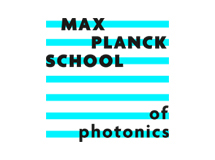Research
Quantum optics – Generation and manipulation of nonclassical states of light
Markus Lippl, Carla Brunner, Vishal Choudhury, Santiago Lopez-Huidobro in collaboration with the group of Maria Chekhova at MPL
For this topic, we study the generation of correlated photon pairs (low-gain) and twin-beams (high-gain) in hollow-core photonic crystal fibres filled with noble gases. The use of noble gasses prevents Raman scattering, which is usually detrimental for the coherence of quantum states generated in fibres. Adjusting the gas pressure in the fibre allows to finely tune the phase-matching condition of the nonlinear process. Recently, we have experimentally demonstrated the first photon pair source with one of the photons in the ultraviolet C-band and its entangled partner, in the near-infrared to infrared spectral range. The frequencies of the generated photons are tunable by adjusting the gas pressure inside the fibre. This source will be useful for quantum sensing technologies “with undetected photons” based on the induced coherence effect [1].
Another promising application of engineered optical fibres is the direct generation of photon triplets. This process, which can be viewed as the quantum conjugate of third-harmonic generation has not yet been reported in the optical frequency domain. Sub-micron tapered fibres embedded in a gas-cell, which allow fine tuning of the dispersion, seems to be the most promising approach.
Lately we showed that using Raman-active gases, we can shift one photon of the generated pair with an efficiency of over 70% without losing the correlations present in the initial source [2]. This opens up new ways to manipulate quantum states. Collaborations with, Ikerbasque Bilbao, Spain, with ENS-Paris (France), and with MIT (US) are on-going using this scheme.

[1] S. Lopez-Huidobro et al., Opt. Lett. 48, 13 (2023)
[2] R. Tyumenev, et al., Science, 376, 621, (2022)
[3] A. Cavanna et al., Phys. Rev. A 101, 033840 (2020)
[4] J. Hammer et al., Phys. Rev. Res. 2, 012079(R) (2020)
[5] J. Hammer et al., Opt. Lett. 43, 2320 (2018)
[6] M. Finger et al., PRL 115, 143602 (2015)
In-situ monitoring of chemical reactions
Florian Schorn, Yu Zhong
This collaboration with the department of chemical and biological engineering has been started lately. By utilizing a hollow-core fibre as reactor, the light can be used for efficiently probing the various compounds of the chemical reaction. The combination of tight confinement and long interaction length allows single-pass spectroscopic measurements using less than µl volume of chemicals with good accuracy. In this way the limitations of both, the chromatographic and the in-situ spectroscopic approach for a classical reaction screening can be circumvented.
As a proof of principle, we used nonlinear Raman spectroscopy for a reaction screening of the acidic catalysed esterification of methanol and acetic acid.
Guidance of magnetic particles in hollow-core PCF
Sisung Kim
Dual beam trapping is widely used because it can guide particles into a hollow-core photonic fibre (HC-PCF) and the trapping in it is very stable. The protected environment provided by the HC-PCF is an ideal system to study the Optomechanics. Lately we started experiments with magnetic particles made of Yttrium Iron Garnet (YIG). The aim is to study the magneto-optical coupling. We recently trapped YIG particles in front of HC-PCF via the dual-beam trapping. By improving the trapping and studying the properties, the applications on the photon-magnon coupling will be further extended.
Rydberg physics at room temperature
Daniel Häupl, in collaboration with the group of Robert Löw at the 5. Institute of physics in Stuttgart
This project aims to combine atomic physics with fibre optics. By trapping light inside hollow-core photonic crystal fibres we aim to enhance the interaction between atoms and light. One application is to generate THz radiation, where the increased interaction length will result in higher emission rates compared to free space.
Another aim is to make the setup even more integrated, to allow for a much more versatile and easier-to-use tool.
[1] G. Epple, et al., Nat. Comm., 5:4132, 2014.
[2] G. Epple, et al., Opt. Lett., 42 (17):3271–3274, 2017
Contact
Joly Research Group
MPI for the Science of Light
Staudtstr. 2
D-91058 Erlangen, Germany





